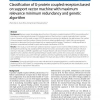46 search results - page 5 / 10 » A Hidden Markov Model for Predicting Transmembrane Helices i... |
BMCBI
2010
13 years 7 months ago
2010
Background: Because a priori knowledge about function of G protein-coupled receptors (GPCRs) can provide useful information to pharmaceutical research, the determination of their ...
ALMOB
2006
13 years 7 months ago
2006
Background: An important challenge in eukaryotic gene prediction is accurate identification of alternatively spliced exons. Functional transcripts can go undetected in gene expres...
ISMB
1996
13 years 8 months ago
1996
We have developed a hidden Markov model (HMM)to detect the protein coding regions within one megabase contiguous sequence data, registered in a database called GenBankin eight ent...
ICPR
2008
IEEE
14 years 1 months ago
2008
IEEE
One of the major limitations of HMM-based models is the inability to cope with topology: When applied to a visible observation (VO) sequence, HMM-based techniques have difficulty ...
BMCBI
2004
13 years 7 months ago
2004
Background: Hidden Markov Models (HMMs) have proven very useful in computational biology for such applications as sequence pattern matching, gene-finding, and structure prediction...

